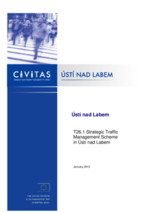Strategic Traffic Management
Thematic areas
Demand & urban space management
- Access restrictions and management
- Road pricing
- Parking management and pricing
Summary
Research was conducted to analyse the conditions and structure of the existing traffic management in the current state, application of intelligent transport systems and transfer of traffic data in the city.On the basis of the results, a proposal for optimal solution for strategic traffic management and ITS development was designed.
Implementing sustainable mobility
Currently, traffic on local roads has reached such a level that it is necessary to address issues of sustainable development and seek complex transport solutions for the city. The possibilities offered by construction of the new transport infrastructure are limited and the trend in the development of motor transport requires application of regulatory measures.
Moreover, specific suitable alternatives and new opportunities must be developed. One objective of the city is aimed at regulation and segregation of motor transport in order to avoid safety risks for the population and to limit emission of harmful gases, noise and vibrations. It furthermore deals with priority for public transport (PT) and support of walking and cycling modes and also promotion for quality and cleaner life in the city.
The City of Ústí nad Labem has a target to develop a traffic management strategy and implement measures to restrict traffic in the city centre. The goal was to improve traffic flow in the city and reduce the environmental impact of traffic.
Progress
The current status of the transport infrastructure and transport equipment on the territory of the city was analysed, which is the basis for gradual implementation of an intelligent transport system.
Detailed description of road infrastructure in the city was described, including pedestrian routes and significant civil engineering works. Specific risks resulting from the local natural and climatic conditions (such as floods, falling rocks from the cliffs, frost and ice, etc.,), as well as risks resulting from industrial activities in the area (such as accidents at factories), were identified.
Current management and organisation of road traffic in the city was described in terms of the system of traffic management via traffic light signals, technological equipment of traffic light devices, comparison of accidents and consequences on traffic light controlled intersections, and traffic management system realised via variable traffic signs.
Collection of traffic data and information was presented. Organisation of parking and parking fees in the city was reviewed. Operation of urban public transport was described. Current organisation of freight transport was identified. Surveillance and rescue systems in the city were presented. Management and maintenance of transport infrastructure was analysed.
Based on the analysis of the current state, proposal for optimal traffic management scheme was developed. The detailed traffic management scheme was designed for the city, including integration of elements of the Intelligent Transport System (ITS). It defined conditions and basic structure of strategic traffic management suitable for Ústí nad Labem, which would increase opportunities for introducing measures to reduce motor traffic in the city centre, to limit negative effects of transport on the city environment and to increase fluency of traffic. It is aimed at improving effectiveness and quality of local transport in a complex way.
Application of transport telematics was proposed in the following functional areas:
- Management and organisation of traffic on roads in the city
- Traffic data and information
- Parking of vehicles
- Public transport
- Freight transport
- Transport surveillance systems
- Emergency systems
- Traffic payments
- Management and maintenance of road infrastructure
Outcomes
Analysis of the current traffic management in the city of Ústí nad Labem was conducted. It describes in detail the architecture of the existing transport subsystems and their mutual integration and communication, which is not optimal and is often realised via telephone connections of operators of individual subsystems. Data transfer is neither rapid nor complete. Therefore, information may not be available to all or to some of the subsystems of traffic management in required time.
Given the large number of separate subsystems for traffic management, road maintenance, PT operation, parking management, management of the Integrated Rescue System, etc., and their problematic interconnection, the proposed solution for strategic traffic management in Ústí nad Labem was not based on the existing architecture of management systems. The reason was particularly the problematic sharing of traffic information, which optimisation would require significant investments and technological and organizational changes.
The more effective solution is to change the entire traffic management system, which would enable integration of all the existing subsystems and continuous real-time sharing of information. The proposal of new traffic management scheme was based on conclusions of the previous study, specifically in terms of identified shortcomings of the current management scheme. The proposal defines an integrated traffic management system gathering, processing, storing and sharing information among the relevant bodies in the city with centralised management. Entities proposed to be included within the architecture of ITS are primarily administrators of roads, units of the IRS and road users (drivers, pedestrians, cyclists and PT passengers). Surveillance and regulation functions were also proposed to be integrated to effectively eliminate violations of traffic rules.
The proposed solution is designed to contribute to improving the quality of transport in the city, increasing traffic flow, improving road safety and lowering negative effects of traffic in the city, including the amount of accidents, injuries, deaths, material damages, emissions, noise pollution. The impact of the proposed traffic management scheme is essential particularly during emergency events, which in Ústí nad Labem typically result from unfavourable weather conditions, such as floods and winter ice and snow. As a result of improved strategic traffic management, the city is more suitable for development of non-motorised transport (pedestrians and cyclists) and for PT services.
The proposal was integrated into the Sustainable Urban Transport Plan of Ústí nad Labem.








